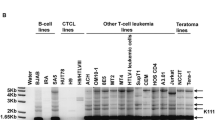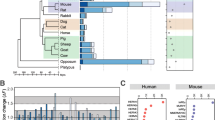Abstract.
Several distinct families of endogenous retroviruses exist in the genomes of primates. Most of them are remnants of ancient germ-line infections. The human endogenous retrovirus family HERV-K represents the unique known case of endogenous retrovirus that amplified in the human genome after the divergence of human and chimpanzee lineages. There are two types of HERV-K proviral genomes differing by the presence or absence of 292 bp in the pol-env boundary. Human-specific insertions exist for both types. The analyses shown in the present work reveal that several lineages of type 1 and type 2 HERV-K proviruses remained transpositionally active after the human/chimpanzee split. The data also reflect the important role of mosaic evolution (either by recombination or gene conversion) during the evolutionary history of HERV-K.
Similar content being viewed by others
Author information
Authors and Affiliations
Additional information
Received: 5 February 2001 / Accepted: 22 March 2001
Rights and permissions
About this article
Cite this article
Costas, J. Evolutionary Dynamics of the Human Endogenous Retrovirus Family HERV-K Inferred from Full-Length Proviral Genomes. J Mol Evol 53, 237–243 (2001). https://doi.org/10.1007/s002390010213
Issue Date:
DOI: https://doi.org/10.1007/s002390010213




